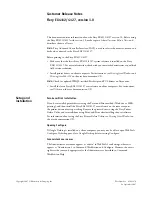
Copyright © 1997-2009 KT&C Co., Ltd. All Rights Reserved.
Korea Technology & Communications Co., Ltd.
71
KVS-1000 User’s Manual
Protocol
- A special set of rules governing how two entities will communicate. Protocols
are found at many levels of communication, and there are hardware protocols and
software protocols.
R.
Router
- A device that determines the next network point to which a packet should be
forwarded on its way to its final destination. A router is often included as part of a
network switch.
RTP
- Real Time Transfer Protocol. A transfer protocol designed for the delivery of live
content, e.g. MPEG4.
RTSP
- Real Time Streaming Protocol is a control protocol, and a starting point for
negotiating transports such as RTP, multicast and Unicast, and for negotiating codecs.
RTSP can be considered a “remote control” for controlling the media stream delivered by
a media server. RTSP servers typically use RTP as the protocol for the actual transport of
audio/video data.
S.
SMTP
- Simple Mail Transfer Protocol is the protocol used to send e-mail across the
Internet. SMTP authentication is a way of allowing people outside of a domain to use an
SMTP server when sending e-mail.
SNMP
- Simple Network Management Protocol. An application layer protocol that
facilitates the exchange of management information between network devices. It is part
of the TCP/IP (Transmission Control Protocol/Internet Protocol) protocol suite.
Subnet Mask
- An IP address consists of two components: the network address and the
host address. “Subnetting” enables a network administrator to further divide the host
part of the address into two or more subnets. The subnet mask identifies the subnet to
which an IP address belongs.
Switch
- Whilst a simple hub transmits all data to all devices connected to it, a switch
only transmits the data to the device it is specifically intended for.
T.
TCP/IP
- Transmission Control Protocol/Internet Protocol. A suite of network protocols
that determine how data is transmitted. TCP/IP is used on many networks, including the
Internet. TCP keeps track of the individual packets of information and IP contains the
rules for how the packets are actually sent and received.
U.
UDP
- The User Datagram Protocol is a communication protocol that offers a limited
amount of service when messages are exchanged between computers in a network that
uses the IP. UDP is an alternative to the TCP and, together with IP, is also known as
UDP/IP.
Unicast
- Communication between a single sender and a single receiver over a network.


































